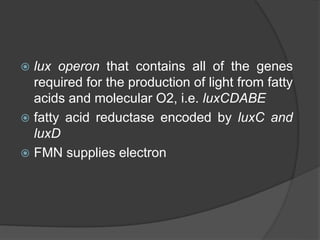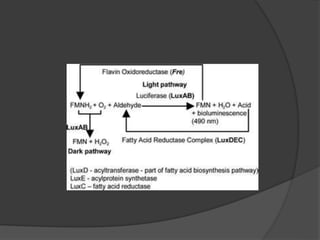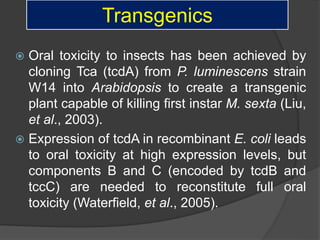Photorhabdus Host of Hosts
- 2. Photorhabdus and a Host of Hosts NEM 199 Seminar 0+1 Presented by, Sujayanand, G.K. Roll no: 9664 Division of Entomology
- 3. Introduction Bacterial transmission in nematodes Bioluminescence Insect defence Pathogenicity in insects Toxins produced Leaping to humans conclusion
- 4. Introduction Family: Enterobacteriaceae Genus: Photorhabdus “glowing rod” – only bioluminescent terrestrial bacterium. Habitat: I. gut of an infective juvenile (Symbiotic) II. in the insect haemolymph (Parasitic) Photorhabdus has mutualistic relationship with nematodes from the family Heterorhabditidae. Soft cuticle, soil-dwelling larvae from the orders Coleoptera, Lepidoptera and Diptera
- 5. highly motile, gram-negative, facultatively anaerobic rods 28◦C on blood agar, where they uniquely produce a thin line of annular haemolysis. Fischer-Le Saux et al. 1999 P. luminescens P. temperata P. asymbiotica Photorhabdus
- 6. Phylogeny
- 9. Bacterial transmission 1 or 2 bacteria 100 cfu in IJ The nematodes feed on Photorhabdus, some bacteria escape crushing by pharynx enter the gut of the hermaphrodite– invade rectal gland cell (bacterial replication). Colonizes IJ - develops within the adult hermaphrodite in a process called endotokia matricida Lipopolysacchride biogenesis: galE and galU : role of bacterial surface in transmission. mutation affects virulence in insects
- 11. Nematode symbiont Photorhabdus on Luria-Bertani agar : nematode same bacteria cultured on lipid agar (nutrient agar supplemented with cod liver oil and corn syrup). Exogenous sterols – for development - bacteriophagous nematode Caenorhabditis elegans, and it is likely that Heterorhabditis will have the same requirement (Chitwood DJ. 1999.) Photorhabdus - iso-branched fatty acids (BCFAs), isoC15:0 - produced - bkdABC operon.
- 12. CipA and CipB have a potential role in nematode nutrition. Heterorhabditis will not grow on just any strain of Photorhabdus, rather it usually requires its specific cognate bacterial strain
- 13. Signal production In Pt NC19, the phosphopantethienyl (PPANT) transferase gene ngrA is required to support nematode growth reproduction STs : polyketide molecules - plants in response to stress and infection and Photorhabdus is the only nonplant organism known to produce. ST is perceived by Heterorhabditis as an indication that food (i.e. bacteria) is plentiful. plu4185-plu4195 involved in the production of a polyketide molecule, anthraquinone. second report of Type II PKS activity in gram- negative bacteria
- 14. Bioluminescence (a) represent a signal from bacteria to bacteria or to the nematode, synchronizing symbiosis; (b) provide a visual aposematic warning to nocturnal scavenging animals; or even (c) act a lure to attract further insect prey to the infected insect cadaver.
- 15. lux operon that contains all of the genes required for the production of light from fatty acids and molecular O2, i.e. luxCDABE fatty acid reductase encoded by luxC and luxD FMN supplies electron
- 17. Symbiotic Vs Pathogenicity a gene with homology to hexA from Erwinia : represses symbiosis factors in P2 - key player in the regulatory network controlling pathogenicity and mutualism Bacterial toxins & hydrolytic enzymes: septicemia Joyce & Clarke
- 19. Pathogenicity TTSS: effector protein, LopT, homologous to YopT from Yersinia →inhibit phagocytosis (Brugirard-Ricaud et al., 2004; 2005). ST: inhibits the activity of PO, an enzyme required for melanin production , involved in stabilization of the nodule. Tc and the Mcf toxins - target and induce apoptosis in, insect immune cells a novel BH3-domain-mediated effect (Dowling et al., 2004 and Waterfield et al., 2005).
- 20. Epithelial cells: local antimicrobial peptides (AMPs) and reactive oxygen species (ROS) fat body and haemocytes major role in innate immunity Recognize invading pathogens, insects use pattern recognition proteins (PRPs) - hemolin, - immulectin-2 (IML-2) and - peptidoglycan recognition protein (PGRP) PRPs bind to conserved pathogen associated molecular pattern (PAMP) in Manduca. Humoral response
- 21. IML-2 is crucial in protecting insects against Gram-negative bacteria and binds to serine proteases in plasma, which participate in activating pro-PO (PPO) to active PO (RNAi)-mediated knockdown of any of these genes results in increased susceptibility to Photorhabdus (Eleftherianos, et al. 2006) silencing of IML-2 prevented normal activation of PO, which was linked to impaired ability of the insect to encapsulate the bacteria (Steiner, 2004) Humoral response
- 22. Humoral response detection of Photorhabdus by PRPs: ↑ transcription levels of AMPs (attacin, cecropin, lebocin, lysozyme and moricin) are high in the Manduca fat body. older Manduca larvae are less able to induce the transcription of PRP and AMP mRNA - host age or developmental stage in bacterial immune challenge. (Eleftherianos, et al. 2008)
- 23. Cellular response One type of cytokine involved in the haemocyte spreading process is plasmatocyte spreading peptide (PSP). Photorhabdus can inhibit phospholipase A2, which catalyzes the first step of eicosanoid biosynthesis and is important for haemocyte nodulation Makes caterpillars floppy 1 (Mcf1) is a toxin that destroys both insect hemocytes and the midgut by apoptosis.
- 24. Photorhabdus toxins with the insect immune system Tcd pathogenicity island
- 25. Phagocytosis evasion TccC3 causes ADP-ribosylation of actin and TccC5 causes ADP-ribosylation of the Rho GTPases RhoA and Rac, resulting in their activation (Lang et al., 2010). Both TccC3 and TccC5 enter the cytosol via TcdA1 where they act together to disrupt the actin cytoskeleton. TccC3 and TccC5 are active against both lepidopteran and human cells. Photox – toxin inhibits the polymerization of actin filaments - effects the cytoskeleton of the target cell (Visschedyk et al., 2010).
- 27. PO cascade inhibition by stilbene
- 28. Nodule formation Dose response curve
- 29. Monoxenic infection ST: broad-spectrum antibiotic - strong antibacterial and antifungal properties Proteinaceous antibacterial molecules S- type pyocins: toxic proteins capable of degrading macromolecules in target cells. E.g. Lumicin R-type pyocins: larger, modified bacteriophage tail structures highly toxic Tcd complex is expressed by Pl W14 early in infection in low amounts and that the highly expressed Tca is produced only after death
- 30. Toxin Complexes (Tcs) The toxin complexes (Tcs) are encoded by the PAI I (pathogenity island I) four such complexes, namely Tca, Tcb, Tcc and Tcd, tca and tcd encode for orally active toxins, responsible for the majority of the insecticidal activity in Manduca secta
- 31. Gut active toxins Tc produced by Photorhabdus is a high molecular weight gut active toxin that is lethal to Lepidoptera, Coleoptera, Hymenoptera and Dictyoptera when injected into the hemolymph or orally ingested. Tca: M. sexta, having a LD50 of 875 ng/cm2 of artificial diet and causing significant weight reduction at 40 ng/cm2
- 32. Transgenics Oral toxicity to insects has been achieved by cloning Tca (tcdA) from P. luminescens strain W14 into Arabidopsis to create a transgenic plant capable of killing first instar M. sexta (Liu, et al., 2003). Expression of tcdA in recombinant E. coli leads to oral toxicity at high expression levels, but components B and C (encoded by tcdB and tccC) are needed to reconstitute full oral toxicity (Waterfield, et al., 2005).
- 33. Photorhabdus Insect Related (Pir) Toxins Photorhabdus insect related (Pir) toxins act as binary proteins. PirA shows little similarity to known proteins PirB shows high homology with the N-terminal region of the pore-forming domain of the Cry2A insecticidal toxin, suggestive of the existence of a similar motif in these binary proteins
- 34. “Makes Caterpillars Floppy” Toxins
- 36. Photorhabdus Genome P. luminescence subspecies laumondii strain TT01 genome was sequenced (Duchaud et al., 2003). Single circular chromosome – 5,688,987 bp with an average GC content - Pa 42.2% - Pl 42.8% 2 paralogs plu4092 and plu4436 encode proteins : JH of Leptinotarsa decemlineata For rapid elimination of insect polyphenols e.g. plu4258 adjacent to glutathione transferase (plu4259).
- 37. P. asymbiotica Pa was first isolated only from clinical infections, with 14 cases reported USA and Australia. Contact with soil as the primary route of infection. most strains of P. luminescens and P. temperata do not grow at temperatures >32°C, whilst P. asymbiotica can grow at 37°C. Pa comprises a single circular chromosome of 5,064,808 bp. Acquired a plasmid related to pMT1 from Yersinia pestis, the causative agent of the bubonic plague(Wilkinson, et al., 2009)
- 38. BLASTCLUST analysis @ 95% identity only 770 predicted proteins are similar between the two genomes but this number increases to 2,823 predicted proteins at the 75% identity level.
- 39. Variation in tca island of Pa Pa tca-island, all of tcaA and most of tcaB are deleted but a new tccC homologue has been acquired
- 40. TTSS variation lopT homolog is absent from the equivalent TTSS island, contain a gene previously termed lopU (pau01043) that is similar to the ExoU effector from Pseudomonas aeruginosa (Brugirard- Ricaud et al., 2004; J Bacteriol, 186(13):4376-4381). ExoU has phospholipase activity that disrupts epithelial and macrophage cell lines (Finck- Barbancon et al., 1997; Mol Microbiol 25(3):547-557)
- 41. Behaviour of GFP labelled Pa ATCC43949 bacteria
- 42. Conclusion Photorhabdus live in a mutualistic relationship with insect pathogenic nematodes of the genus Heterorhabditis. This symbiosis is highly evolved and is highly strain specific. Photorhabdus and its interaction with the immune system. The large repertoire of secondary metabolite gene clusters suggests these bacteria represent an excellent source of novel drug candidates.
- 43. P. asymbiotica is capable of causing infections in humans, providing an excellent model of an emerging human pathogen. The ability to extend this fully functional bacterial lux system to eukaryotic cells opens many opportunities for continuous bioprocess monitoring, high-throughput screening systems, and in vivo sensor and diagnostic applications.











































